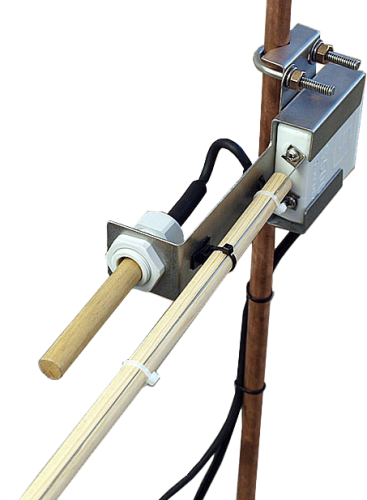
Cabled for connecting to RAWS-P stations






Overview
The CS516-LQ consists of a CS506 Fuel Moisture Probe, a 26601 10-hour Fuel Moisture Stick, a CS205 Fuel Temperature Stick, and a 107 Thermistor mounted on a 26817 Mounting Stake. The cables on the CS506 and 107 probes have a user-specified length and terminate in a military style connector instead of pigtails. The connector attaches to the RAWS-P enclosure, which mounts to a Campbell Scientific tripod or tower.
Read MoreImages

Detailed Description
Fuel temperature is measured by inserting the thermistor-based 107 probe inside of the CS205 dowel. Dowel replacement is recommended every spring; more frequent replacement may be required in some environments (i.e., those with a large number of wet/dry cycles).
The CS506 Fuel Moisture Sensor consists of an epoxy-encapsulated electronics package. It uses Time Domain Reflectometry to measure the moisture content of the USFS-specified, 10-hour, ponderosa pine dowel. No artificial materials (e.g., epoxy sealant) are added to the dowel that would adversely influence the natural behavior characteristics of it. Because the complete dowel surface is accessible for moisture exchange, the response of the CS506 is similar to that of the traditional weighing racks.
To optimize probe-to-probe repeatability and to allow probe interchangeability without individual calibration, two additional sorts are performed on the dowels before they are selected to be used as a sensor. First, the dowels are sorted dry by density to improve accuracy in the dry range of 0 to 15%. Second, the dowels are sorted after a 50-minute soak by weight to reduce probe-to-probe time response variation and minimize variability in the wet range of 20 to 50%.
Compatibility
The cables on the CS506 and 107 probes have a user-specified length and terminate in a military style connector instead of pigtails. The connector attaches to the RAWS-P enclosure, which mounts to a Campbell Scientific tripod or tower.
The CS516-LQ is not compatible with data loggers in the CR300 series and the CR200(X) series.
Specifications
Fuel Moisture |
|
| Enable Voltage |
|
| Operating Range | 0 to 70% moisture content |
| Power Supply | 5 to 18 Vdc |
| Current Use |
|
| Output Signal | ±0.7 Vdc square wave (with an output frequency of approximately 31 to 58 kHz) |
Fuel Temperature |
|
| Sensor | BetaTherm 100K6A1B Thermistor |
| Tolerance | ±0.2°C (over 0° to 50°C range) |
| Temperature Measurement Range | -35° to +50°C |
| Steinhart-Hart Equation Error | ≤ ±0.01°C (over measurement range) |
Fuel Moisture Accuracy |
|
| 0 to 10% Range |
|
| 10 to 20% Range |
|
| 20 to 30% Range |
|
| 30 to 50% Range |
|
Documents
Frequently Asked Questions
Number of FAQs related to CS516-LQ: 2
-
Both the 26601 10-Hour Fuel Moisture Stick (used with the CS506-L) and the CS205 10-Hour Fuel Temperature Stick (used with the 107-L) can be easily replaced in the field with a Phillips screwdriver and an adjustable wrench.
The dowels should be replaced each spring; more frequent replacements may be required in some environments. The more wet/dry cycles the dowels experience, the more frequently they will need to be replaced.
-
For descriptions and illustrations (with part numbers) of the various instruments used in measuring fuel temperature and moisture, see the "Remote Measurements" brochure.